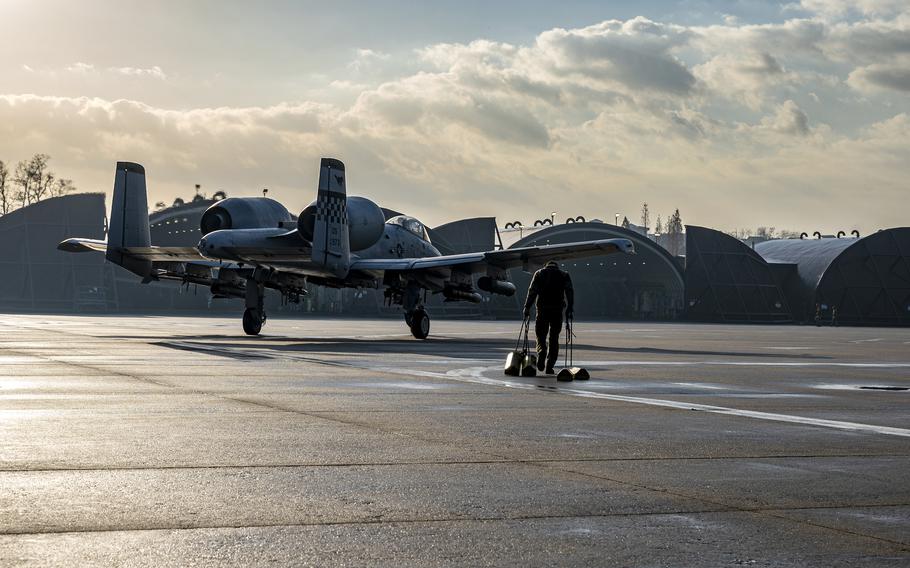
An airman walks toward an A-10C Thunderbolt II, affectionately known as the Warthog, at Osan Air Base, South Korea, Dec. 7, 2022. (Dwane Young/U.S. Air Force)
The Air Force is retiring A-10 Thunderbolt IIs from South Korea and upgrading its F-16 Fighting Falcons there as part of a “modernization effort” across the service, according to a news release Tuesday.
Starting in January, all 24 A-10s assigned to the 25th Fighter Squadron at Osan Air Base will be relocated in phases to the 309th Aerospace Maintenance and Regeneration Group in Davis-Monthan Air Force Base, Ariz., 7th Air Force spokeswoman Maj. Rachel Buitrago told Stars and Stripes by email Wednesday. They’ll undergo maintenance and display preparations in Arizona.
The A-10s will not be immediately replaced, according to Buitrago. The plane is better known as the Warthog, for its rugged durability and distinctive armament.
F-35A Lightning IIs, F-16s, FA-50 Golden Eagles and F-15K Slam Eagles from the U.S. and South Korean air forces “are more than ready to fill the role of the A-10” on the peninsula, Buitrago added. The two services are “confident in their ability to bring the full spectrum of combat capabilities to defend [South Korea] during crisis and conflict,” she said.
The 7th Air Force, headquartered at Osan, plans to outfit its fourth-generation F-16s with “pivotal upgrades,” including a new avionics system to bring it “closer to fifth-generation capabilities” beginning next year, according to the Air Force news release.
The plan to upgrade F-16s and remove the A-10s mirrors a similar move in Japan by the Pentagon to replace older F-15 Eagles at Kadena Air Base, Okinawa, with the improved F-15EX fighter and replace F-16s at Misawa Air Base in northern Japan with 48 F-35As. The Navy is also swapping F/A-18 Super Hornets for F-35Cs at Marine Corps Air Station Iwakuni in southern Japan.
The F-16 makes up about 50% of the Air Force fleet and has flown in every major U.S. conflict since the 1970s. In 2022, the service allocated $6.3 billion for improvements to its F-16s, which pilots have described as a modular aircraft that is easily upgraded with new equipment.
“The modernization effort seeks to ensure peace and stability in the Indo-Pacific region, including the Korean Peninsula, through state-of-the-art aircraft,” the Air Force release said. “The strategy bolsters deterrence against North Korea and reaffirms the ironclad U.S. security commitment to the South Korea-U.S. alliance by strengthening South Korean and U.S. combined defense.”
The single-seat A-10 has proven its worth by providing close-air support for ground forces since it entered service in 1976. It is equipped with the infamous seven-barrel 30 mm Gatling gun and can carry up to 16,000 pounds of ordnance.
The Air Force plans to divest 56 A-10s from its inventory in the upcoming fiscal year, according to an undersecretary of defense budget report published April 4.
Talk of retiring the aircraft has circulated around the Pentagon since the 1980s. Critics of the A-10 have argued its singular role of providing ground support is outdated in the contemporary battlefield and ought to be replaced with something that can also face off against aerial and anti-air threats.